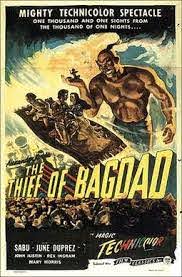
“Has the world got a roof?” “Of course. Supported by 7 pillars and the 7 pillars are set on the shoulders of a genie whose strength is beyond thought. And the genie stands on an eagle, and the eagle on a boor, and the boor on a fish, and the fish swims in the sea of eternity.”
Ahmad (John Justin) is the sultan of Bagdad. He is young and is being ill advised by his devious Grand Vizier Jaffar (Conrad Veidt). Because of Jaffar’s influence the people of Bagdad appear to live in fear. When Ahmad wants to know why his people are unhappy and fear him Jaffar convinces him to go out among his subjects posing as a beggar to find out their true feelings.
Jaffar has Ahmad tossed into prison as a mad man and has him sentenced to death. Also thrown into prison is a young thief named Abu (Sabu). Abu steals the jailer’s keys and they escape. They steal a small boat and travel to Basra. In Basra Ahmad sees the Sultan’s (Miles Malleson) daughter (June Duprez). Ahmad has Abu sneak him into the palace where he meets the Princess. They fall in love.
Jaffar arrives in Basra and convinces the Sultan to give him his daughter’s hand in marriage. The princess, now in love with Ahmad, runs away. When Ahmad tries to confront Jaffar the vizier, who is also a wizard, he blinds Ahmad and turns Abu into a dog. Jaffar finds the princess but she falls into a deep sleep and cannot be awakened. Jaffar has his servant Halima (Mary Morris) trick Ahmad into awakening the Princess.
Jaffar sails away with the Princess. The spell over Ahmad and Abu gets broken and they return to their normal selves. When Ahmad and Abu try to follow, Jaffar creates a storm. Ahmad and Abu get separated and end up washed up on a foreign shore. When Abu finds a bottle on the beach containing a Genie (Rex Ingram)his adventures really begin.
“The Thief of Bagdad” was released in 1940 and was directed by Michael Powell, Ludwig Berger and Tim Whelan. Also directing were uncredited Alexander Korda, Zoltan Korda, and William Cameron Menzies. It is a British made fantasy/adventure film. It won Academy Awards for Cinematography, Art Direction and Special Effects. It was also nominated for Original Music Score which was the first time a British film score had been recognized at the Academy Awards.
Although it was a British production the advent of World War II and the Blitz necessitated that the film be completed in California. Some scenes were shot in and around the Grand Canyon. When the filming began in the U.S. the Production Code kicked in and adjustments were made to comply with the code. The most notable difference is in the cleavage shown in the British scenes verses the American scenes where the actresses’ blouses are buttoned all the way to the top.
This was the first major use of blue screening in film. Sabu was fifteen when the film was made. Many of his earlier scenes had to be reshot in the U.S. due to his growing several inches. Most of the 18 riders who clear the market prior to the Princess' procession are women. It is believed that this was because so many men had been taken into the British armed forces at the time.
The film is a remake of the 1924 silent film starring Douglas Fairbanks Sr. One of the main differences between the two films is that thief and the romantic lead were one and the same in the 1924 version. In the 1940 film, they are two separate characters.
Of course the most memorable part of the film is the Genie. Rex Ingram as the Djinn is phenomenal. The whole film is a colorful and whimsical fantasy film that is appropriate for all ages. Although not technically part of the original Italian style sword and sandal film genre it manages to nestle snugly within the broader scope of the genre due to the films characteristics. It is an adventure film and it does have the evil vizier with his eye on the throne and the damsel in distress. The only thing missing is the muscle bound he-man

